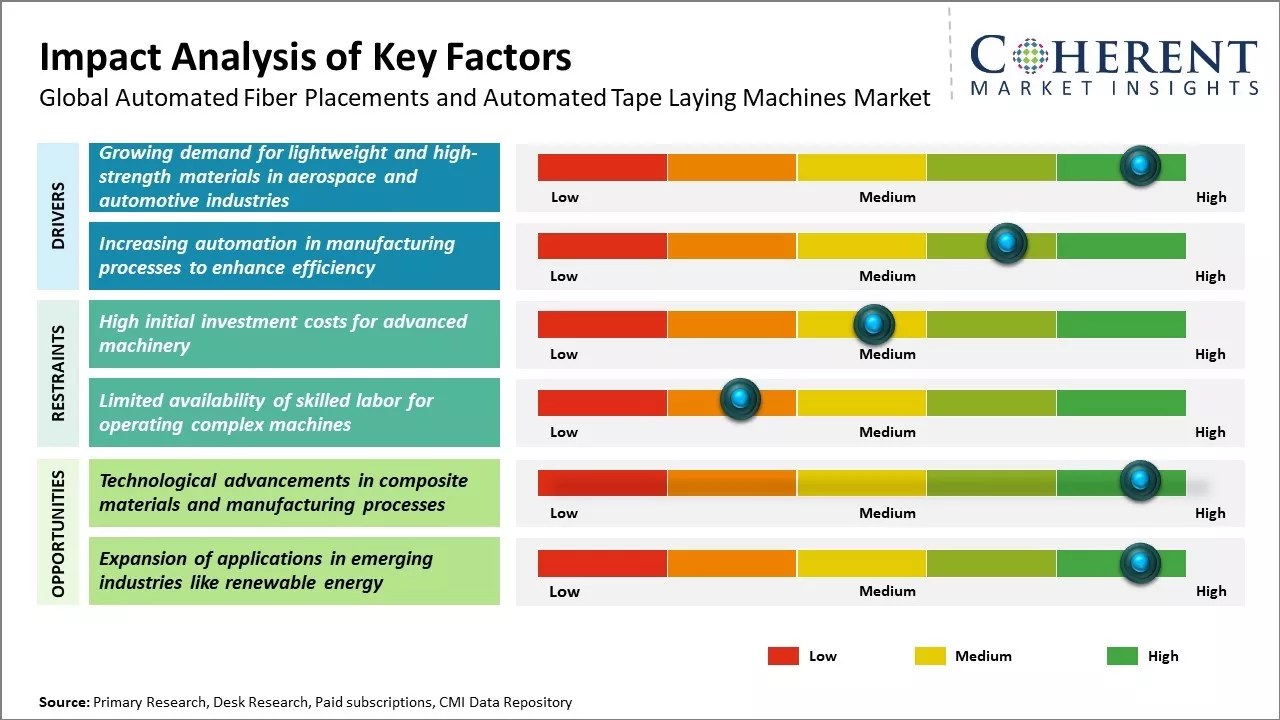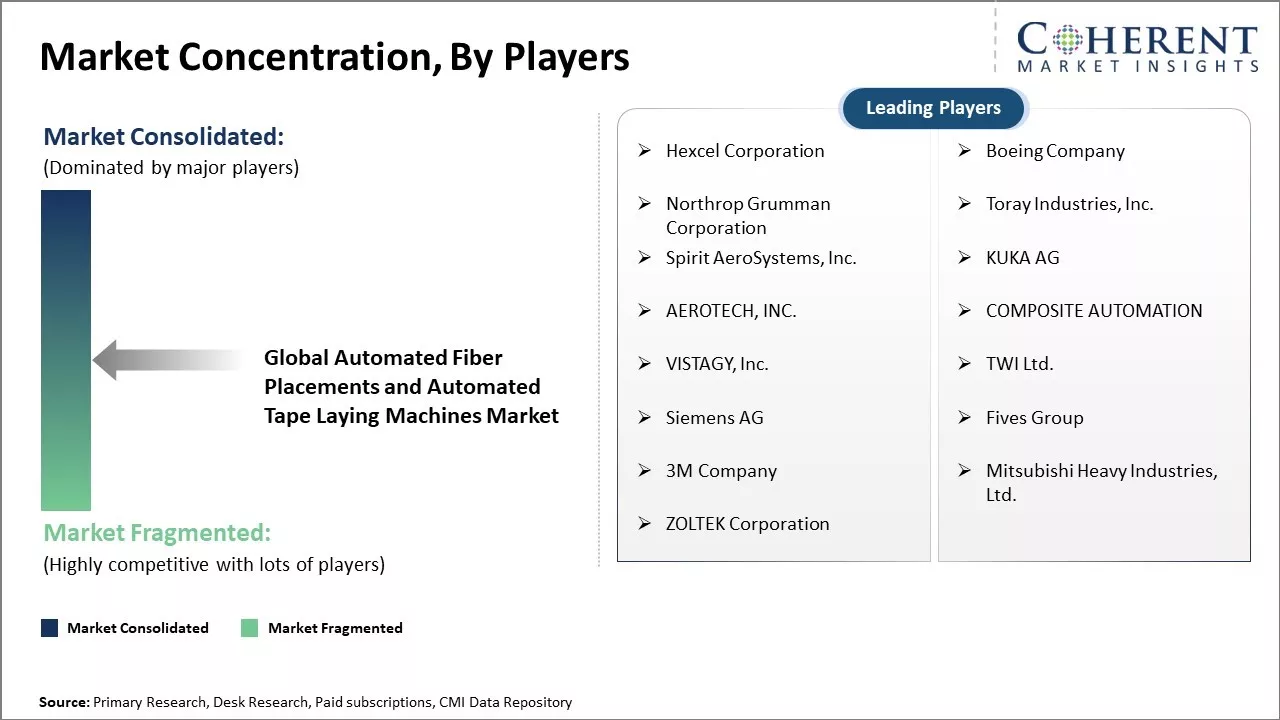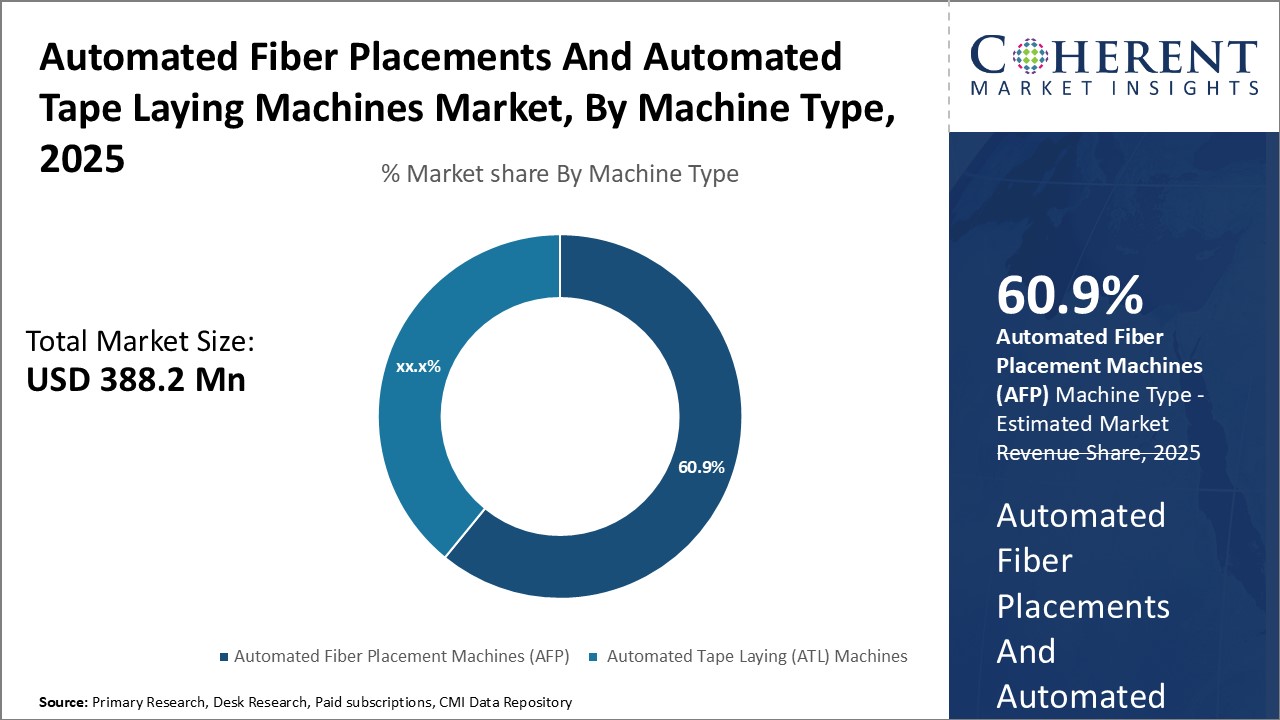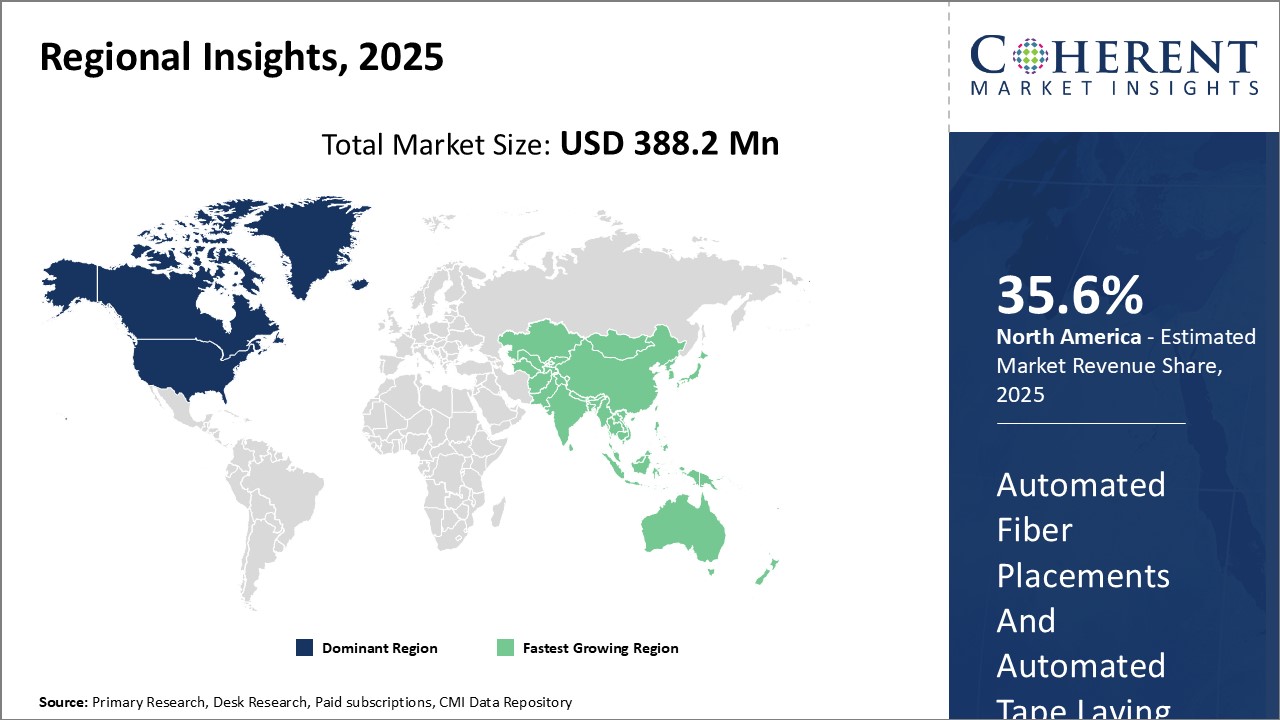
Global automated fiber placements and automated tape laying machines market is estimated to be valued at US$ 388.2 Mn in 2025 and is expected to reach US$ 710.1 Mn by 2032, exhibiting a compound annual growth rate (CAGR) of 9.0% from 2025 to 2032.

Discover market dynamics shaping the industry: Download Free Sample
Rapid adoption of advanced composites in industries, such as aerospace and defense, transportation, and wind energy, is expected to drive the demand for automated fiber placement and tape laying machines market during the forecast period. The Global Automated Fiber Placements and Automated Tape Laying Machines Market is witnessing positive growth driven by factors such as rising need for lightweight and fuel-efficient aircraft/automobiles along with focus towards renewable energy. Additionally, growing automation in composites manufacturing is boosting the market growth. Technologies integrated with automated fiber placements and tape laying machines such as robotics and internet of things (IoT) are also expected to gain significant traction in the coming years.
Growing demand for lightweight and high-strength materials in aerospace and automotive industries
The aerospace and automotive sectors have always looked for ways to enhance the performance of their products while meeting stringent sustainability targets. One of the ways this has been achieved is by adopting lightweight yet high-strength materials that can reduce the overall weight of vehicles and aircraft. Composite materials like carbon fiber have emerged as a popular choice due to their superior properties. However, the manual production of carbon fiber parts is a complex and labor-intensive process with low repeatability. This is where automated fiber placement and automated tape laying machines have created a disruption.
With AFP/ATL machines, long rolls of raw materials like carbon fiber tapes can be precisely placed onto a mold using computer-controlled depositor heads. The materials consolidate under heat and pressure to form durable composite parts. As the machines automate most of the production steps, they offer higher throughput than manual lamination. More importantly, they ensure consistency in fiber steering and placement which traditional hand-layup methods struggle with. This directly translates to improved part quality and performance. No wonder then that leading aerospace manufacturers are opting for AFP/ATL to produce critical load-bearing components for commercial and military aircraft.
Similarly, automakers see composites as an opportunity to slim down vehicle weight and meet stringent emission regulations. Carbon fiber hoods, roofs, and body panels can help offset the weight of larger and more powerful electric powertrains. AFP/ATL came at the right time for automotive OEMs who want to leverage these benefits at scale. The technology has demonstrated its flexibility to produce various prototype parts and is now being integrated into production lines as well. As composites disrupt vehicle architectures, the demand for advanced composite manufacturing machinery like AFP/ATL can only accelerate.

Get actionable strategies to beat competition: Download Free Sample
Increasing automation in manufacturing processes to enhance efficiency
Due to various economic and business pressures, manufacturers across industries are constantly looking at automating processes to improve output while cutting costs. Automating material layup using fully automated fiber placement and tape laying machines is seeing growing popularity for its efficiency benefits. Compared to traditional hand layup of composite parts which is time-consuming, these machines achieve higher labor productivity. Not only can they place materials continuously in a layered fashion 24x7, but one operator can manage multiple machines remotely.
This round-the-clock utilization ensures maximum equipment effectiveness. It also helps reduce overhead costs associated with a large workforce. The machines optimize material usage through precise placement, thereby lowering raw material wastage. Their ability to accurately translate CAD models into fiber steering commands results in superior part quality and repeatability compared to manual methods. This translational accuracy fosters manufacturability. More automation also means more traceability of machine and process parameters essential for quality assurance in highly regulated industries like aerospace and medical devices.
For instance, In August 2023, KUKA, a leading global provider of automation solutions and robotics, launched a new automated tape laying machine designed for high-speed applications. This innovative machine aims to enhance efficiency in composite manufacturing, particularly for industries such as aerospace and automotive, where precision and speed are critical. The introduction of this advanced technology reflects KUKA's commitment to driving automation and improving production processes in the rapidly evolving manufacturing landscape.
Key Takeaways from Analyst:
Global market for automated fiber placements and automated tape laying machines is expected to witness strong growth driven by various factors like increasing demand for lightweight and durable composite materials from the aerospace industry. As aviation regulations become stricter regarding fuel efficiency and emissions, manufacturers are compelled to use composites extensively in aircraft production. This, in turn, is likely to boost THE demand for automated fiber placement and tape laying machines which improve production efficiency compared to manual laying of fibers and tapes.
However, high initial investment required for these capital-intensive machines may slow down their penetration rate, particularly among smaller part manufacturers. Significant maintenance costs associated with automated machines could also deter potential buyers. Besides, the lack of skilled operators and difficulty in programming customized layup pose challenges for full utilization of capabilities.
On the geographic front, North America led by the U.S. is anticipated to remain the dominant regional market due to a large presence of leading aerospace OEMs. Meanwhile, the Asia Pacific region especially China is expected to witness the fastest growth supported by heavy investments in domestic aviation programs and local requirement of composites in other industries like offshore energy and infrastructure. Key players should focus on enhancing machine productivity and capabilities through innovations to tap new application areas beyond aerospace and enlarge.
Market Challenge - High initial investment costs for advanced machinery
The high initial costs associated with automated fiber placement and tape laying machines poses significant challenges for widespread adoption, especially among smaller manufacturers. These advanced machineries require substantial capital expenditure running into millions of dollars depending on the level of automation and features. The high precision CNC controlled equipment needs sophisticated components and software programs developed through extensive research and testing. The manufacturing and setup of such complex systems also contributes to increased prices. For many businesses, allocating such large budgets may not be feasible and deters them from fully automating production. High costs can render such technologies out of reach for all but the largest corporate players. Accessing financing also needs careful planning. Overall, the heavy price tags pose big entry barriers for the market and slower its growth rates currently compared to potential.
Market Opportunity - Technological advancements in composite materials and manufacturing processes
Significant opportunities exist for the global automated fiber placement and tape laying machines market through ongoing technological advancements. Composite materials continue to witness innovations widening their usage across major industries. Newly developed high-performance polymers and reinforcements expand possible applications. At the same time, machinery manufacturers are incorporating cutting-edge robotics, artificial intelligence, big data and smart sensors into their systems. Such innovations enhance machine capabilities like processing complex geometries with more precision at high-production rates. They improve quality control, reduce waste and supply chain inefficiencies. Data-driven insights also pave way for predictive maintenance programs. Overall, ongoing innovations in materials and manufacturing technologies are expanding potential end-use sectors. They are increasing demand for advanced automated composites production systems. This presents lucrative prospects for long-term market value growth.

Discover high revenue pocket segments and roadmap to it: Download Free Sample
Insights By Machine Type - Innovation and precision drives growth in automated fiber placement (AFP) machines segment
In terms of machine type, the automated fiber placement (AFP) machines segment is estimated to contribute the highest market share of 60.9% in 2025 owing to its unmatched ability to precisely place fibers and cut down production time. AFP machines allow for automated high-speed fiber placement on doubly-curved tool surfaces or aircraft fuselages with greater design flexibility. The precision of AFP machines give engineers more control over fiber steering which helps improve the strength and stiffness of parts.
AFP machines also allow dramatic reductions in labor costs compared to manual layup methods. As aerospace production volumes increase to meet demand, AFP machines are increasingly used to replace hand layup techniques and speed up fabrication of complex composite parts. Their automated fiber placement head can lay tape at very high rates without breaks or seams. Manufacturers are constantly innovating new AFP head designs with more advanced controls and motion abilities to place fibers in narrow cavities and pockets. The development of scanners and vision systems has also enhanced AFP machine integration within production environments.
Insights By Material Type - Strength and weight reduction drives growth in carbon fiber segment
In terms of material type, the carbon fiber segment is estimated to contribute the highest market share of 64.7% in 2025 owing to its exceptional strength to weight ratio and customizability. Carbon fibers are extremely strong yet very light, and parts made with carbon fiber-reinforced polymers can be over 15 times stiffer than traditional metal while weighing about half as much. The higher specific strength and stiffness of carbon fiber allows for weight savings in transportation and industrial components.
Weight reduction translates directly to performance improvements - less weight means less fuel is needed to move a vehicle or part. In the aerospace industry where every gram counts, the benefits of carbon fiber have led to its widespread adoption in commercial and military aircraft. Carbon fiber is also highly customizable since fibers can be placed and aligned as needed to reinforce strength in load-bearing directions. This ability to tailor physical properties makes carbon fiber attractive for applications with complex requirements. With advances in carbon fiber production and lower costs, its use is growing in automotive, wind energy, marine, and other industrial sectors.
For instance, In February 2023, Hexcel, a global leader in advanced lightweight composites technology, introduced a new line of advanced carbon fiber materials specifically designed for Automated Fiber Placement (AFP) applications. This new product line aims to enhance the efficiency and performance of composite manufacturing processes, particularly in the aerospace sector, where high-quality materials are crucial for structural integrity and weight reduction. The launch reflects Hexcel's commitment to innovation and its role in advancing the capabilities of composite materials in various industries.
Insights By Application - Complexity drives growth in aerospace segment
In terms of application, the aerospace segment is estimated to contribute the highest market share of 42% in 2025 owing to increasingly complex part designs. Aerospace presents some of the most demanding engineering challenges due to stringent performance and reliability needs. Aircraft include an immense number of intricate interior and exterior parts with compound curves and geometries that are difficult to fabricate with traditional manufacturing.
Advancements in aircraft and engine technologies are also driving new highly-optimized lightweight composite designs. Features like blended wing bodies, segmentation control surfaces and nacelles require innovative materials and production methods for assembly. Automated fiber placement and tape laying machines are well-suited for the aerospace industry due to their ability to precisely deposit fibers on double-curved tools and tightly control fiber steering around complex architectures. Their high speed and precision allow for cost-efficient production of integrated structures and one-piece shell components.
As next-generation aircraft programs push for even more composites use, innovative automated fiber placement technologies are helping manufacturers overcome the engineering and production challenges of producing stronger yet lighter airframes. The aerospace industry's increasing focus on efficiency, performance and lifecycle costs will continue to drive demand for automated fiber placement and tape laying machinery.

Need a Different Region or Segment? Download Free Sample
North America has established itself as the dominant region in the global automated fiber placements and automated tape laying machines market. The region is expected to hold 35.6% of the market share in 2025. With the presence of major companies like Mazak Corporation and Cincinnati Incorporated, the U.S. has become the global production and development hub for these machines. Major aerospace companies like Boeing and Airbus have their manufacturing bases in the U.S., driving significant demand for automated fiber placement technology to be utilized in aircraft component manufacturing.
The automotive industry is also growing rapidly in the U.S. and Canada, with more emphasis being given to the use of lightweight composites. This is increasing the need for automated fiber placement machines that can handle high production volumes required in the automotive sector. Additionally, the region has a highly developed industrial infrastructure with presence of skilled workforce familiar with advanced manufacturing technologies. This allows seamless integration of new automated fiber placement systems into the production lines.
On the other hand, the Asia Pacific region is emerging as the fastest growing market. Presence of developing economies like China and India is providing numerous opportunities for expansion of composites end-use industries like wind energy, construction and infrastructure. Both countries are aggressively investing in renewable energy projects and construction of public infrastructure like bridges, tunnels etc., where automated fiber placement machines can offer design and production benefits.
China especially is making huge investments in wind turbine manufacturing capacity expansion. This is attracting major wind turbine OEMs to set up local manufacturing bases in China. They are increasingly adopting automated tape laying machines to cater to the high production volumes needed in the growing Chinese wind energy market.
Automated Fiber Placements and Automated Tape Laying Machines Market Report Coverage
| Report Coverage | Details | ||
|---|---|---|---|
| Base Year: | 2024 | Market Size in 2025: | USD 388.2 Mn |
| Historical Data for: | 2020 To 2024 | Forecast Period: | 2025 To 2032 |
| Forecast Period 2025 to 2032 CAGR: | 9.0% | 2032 Value Projection: | USD 710.1 Mn |
| Geographies covered: |
|
||
| Segments covered: |
|
||
| Companies covered: |
Hexcel Corporation, Boeing Company, Northrop Grumman Corporation, Toray Industries, Inc., Spirit AeroSystems, Inc., KUKA AG, AEROTECH, INC., COMPOSITE AUTOMATION, VISTAGY, Inc., TWI Ltd., Siemens AG, Fives Group, 3M Company, Mitsubishi Heavy Industries, Ltd., and ZOLTEK Corporation |
||
| Growth Drivers: |
|
||
| Restraints & Challenges: |
|
||
Uncover macros and micros vetted on 75+ parameters: Get instant access to report
*Definition: The global automated fiber placements and automated tape laying machines market consists of machinery that utilizes computer numerical control (CNC) to automatically place reinforcing fibers or tapes on molds or surfaces to produce composite materials. These machines automate the fiber placement and tape laying processes for making advanced composite parts for industries like aerospace, defense, transportation, and wind energy in a more precise and cost-effective manner.
Share
Share
About Author
Ramprasad Bhute is a Senior Research Consultant with over 6 years of experience in market research and business consulting. He manages consulting and market research projects centered on go-to-market strategy, opportunity analysis, competitive landscape, and market size estimation and forecasting. He also advises clients on identifying and targeting absolute opportunities to penetrate untapped markets.
Missing comfort of reading report in your local language? Find your preferred language :
Transform your Strategy with Exclusive Trending Reports :
Frequently Asked Questions
Joining thousands of companies around the world committed to making the Excellent Business Solutions.
View All Our Clients